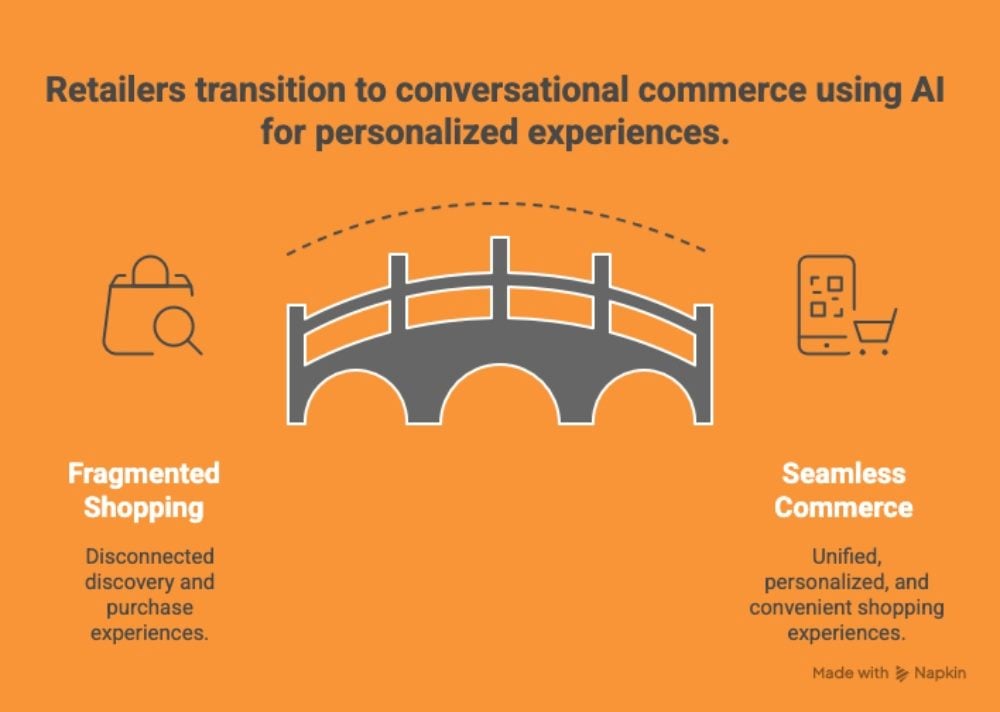Developer Offer
Try ImaginePro API with 50 Free Credits
Build and ship AI-powered visuals with Midjourney, Flux, and more — free credits refresh every month.
The Future of Shopping is a Conversation with AI
OpenAI is extending its influence from general AI into a new frontier: ecommerce. With the launch of Instant Checkout, ChatGPT has officially been transformed from a discovery tool into a complete commerce platform, signaling a fundamental shift in how customers discover and purchase products online.
This new feature, powered by an Agentic Commerce Protocol developed with Stripe, allows users to buy directly from Etsy and over one million Shopify merchants without ever leaving their chat conversation. This collapses the traditional ecommerce journey into a seamless chat-to-checkout experience, raising new expectations for customer experience (CX). As AI gains more purchasing autonomy, CX leaders must redefine safeguards and metrics in a world where the customer experience becomes inseparable from conversation.
Introducing Instant Checkout in ChatGPT
Instant Checkout lets ChatGPT users complete purchases directly within the conversational interface. When a user asks a shopping-related question, such as finding the "best running shoes under $100" or "gifts for a ceramics lover," ChatGPT displays relevant products. For items enabled with this feature, a "Buy" button appears, allowing the transaction to be completed right in the chat.
The foundation of this is the Agentic Commerce Protocol, an open-source standard that creates a secure payment framework. ChatGPT acts as the user's AI agent, passing information between the customer and the merchant. Importantly, the merchant retains full control as the merchant of record, handling orders, payments, fulfillment, and post-purchase customer relationships.
Currently available for single-item purchases for U.S. users, OpenAI plans to expand to multi-item carts and other regions. The company stresses that product recommendations are organic and unsponsored, ranked purely by relevance. Merchants pay a small transaction fee, but the service is free for customers and does not affect product prices.
A New Standard for Frictionless Shopping
For years, digital platforms have tried to reduce the friction in online shopping, where multiple tabs, re-entering payment info, and account creation lead to abandoned carts. While social commerce aimed to solve this, it never fully delivered a seamless experience.
OpenAI's Instant Checkout promises a "chat to checkout in just a few taps." A customer can ask for gift ideas, see curated recommendations, and complete the purchase without ever leaving the conversation. For Plus and Pro subscribers, prefilled shipping and payment details make the process even faster. This level of convenience sets a new, significantly higher bar for the digital customer experience. If customers can buy something in seconds through a conversation, they will start expecting similar ease everywhere.
Building Trust in an AI-Powered Marketplace
A major implication for customer experience involves trust. OpenAI states that product results are "organic and unsponsored, ranked purely on relevance," and that Instant Checkout availability does not influence rankings. When multiple merchants offer the same product, ChatGPT considers factors like price, availability, and quality to optimize the user's experience.
However, this new environment changes how customers evaluate trust. Online shoppers have learned to identify sponsored content and ads. In conversational AI, these visual cues disappear. The experience feels more like getting advice from a friend, but the recommendation mechanisms are opaque. Maintaining customer trust will demand ongoing transparency from OpenAI about how these decisions are made.
Who Owns the Customer Relationship?
Unlike marketplace models that intermediate the customer relationship, OpenAI positions itself as the user's "AI agent." Merchants remain the merchant of record, handling all aspects of the order after the sale. OpenAI even requests that merchants do not sign users up for marketing emails from their ChatGPT orders.
This creates a potential friction point. A customer who buys in a conversation may expect to resolve issues conversationally. They might ask ChatGPT about their order status or a return, but the actual resolution still requires engaging with the merchant directly. For retailers, this means the post-purchase experience must be as seamless as the buying process to avoid a jarring disconnect.
The Power of Personalization and AI Memory
ChatGPT's existing features, like Memory and Custom Instructions, allow for deeply personalized commerce. The AI can remember your preferences for sustainable products, your budget, or the interests of people you shop for. This contextual awareness enables recommendations that feel genuinely helpful, not algorithmically generic. This shifts commerce from being session-based to a persistent, relationship-based dialogue. However, it also requires a careful approach to privacy and consent, as customers may not fully realize how their conversational data is shaping their shopping experience.
The Next Frontier Agentic Commerce
While Instant Checkout currently supports single-item purchases, the long-term vision is what OpenAI calls "agentic commerce," where AI makes purchases on your behalf. Imagine asking ChatGPT to "restock my pantry with my usual staples" and having it autonomously complete the order. OpenAI insists that users will remain in control, confirming each step. But as AI autonomy grows, it introduces new CX challenges. How are mistakes handled? What safeguards prevent accidental purchases? These are critical questions for the future of agentic commerce.
From Discovery to Purchase in a Single Flow
Traditional ecommerce separates discovery (on search engines or social media) from purchase (on a retailer's website). ChatGPT collapses this entirely. A conversation about decorating an apartment can seamlessly lead to buying furniture without the user ever consciously entering a "shopping mode."
This fluidity is convenient but removes traditional decision-making points like price comparisons and review checks. Retailers must ensure their product data, reviews, and return policies are easily accessible within these new conversational contexts to build buyer confidence.
Strategic Actions for Retail Leaders
Ecommerce and CX professionals can take these steps to prepare for the rise of conversational commerce.
| Action | Recommendation |
|---|---|
| Prepare for conversational commerce expectations | Even customers who never use ChatGPT shopping will expect its convenience. Streamline your checkout to minimize steps between discovery and purchase. |
| Ensure your product data is AI-ready | ChatGPT relies on structured data—pricing, inventory, and descriptions—to recommend accurately. Optimize catalogs for AI parsing, not just human browsing. |
| Strengthen post-purchase CX | Make order tracking, returns, and support as effortless as buying through chat. Consider adding conversational AI support on your own channels. |
| Maintain transparent pricing and policies | AI shoppers may buy without visiting your site. Ensure your product feeds include clear pricing, shipping, and return data to prevent confusion. |
| Rethink customer acquisition costs | OpenAI’s per-transaction fees shift focus from ad-driven discovery to conversion-based models. Reevaluate your acquisition and retention ROI. |
| Plan for autonomous shopping | Prepare for AI-driven, recurring purchases where customer oversight decreases. Define safeguards, limits, and opt-ins to maintain control and trust. |
The Broader Shift to Conversational Commerce
OpenAI's initiative is part of a larger trend of embedding commerce into conversational interfaces. While Meta and Google are also active in this space, OpenAI's approach is the most complete implementation to date. By open-sourcing the Agentic Commerce Protocol, OpenAI is positioning this as foundational infrastructure, not just a feature, which could challenge established players like Amazon's Alexa.
How to Measure Success in This New Paradigm
Traditional ecommerce metrics like bounce rate and cart abandonment don't apply here. Success must be measured in new ways.
| Metric | Definition |
|---|---|
| Recommendation acceptance rate | Percentage of purchases made from ChatGPT’s initial suggestions versus alternatives. |
| Conversational conversion | Ratio of shopping-related prompts that end in a completed transaction. |
| Repurchase through conversation | Share of customers returning to ChatGPT for repeat or follow-up purchases. |
| Post-purchase satisfaction | Customer-reported satisfaction after buying through ChatGPT, including fulfillment and support quality. |
| Preference drift | How accurately ChatGPT adapts to a customer’s evolving preferences and feedback over time. |
Key Questions for the Future
The launch of Instant Checkout raises as many questions as it answers for the customer experience. How will returns and order modifications work? What happens when a recommended product is out of stock? How will subscription services be handled? Answering these practical questions will determine whether conversational commerce can truly deliver the seamless experience it promises.
Compare Plans & Pricing
Find the plan that matches your workload and unlock full access to ImaginePro.
| Plan | Price | Highlights |
|---|---|---|
| Standard | $8 / month |
|
| Premium | $20 / month |
|
Need custom terms? Talk to us to tailor credits, rate limits, or deployment options.
View All Pricing Details


